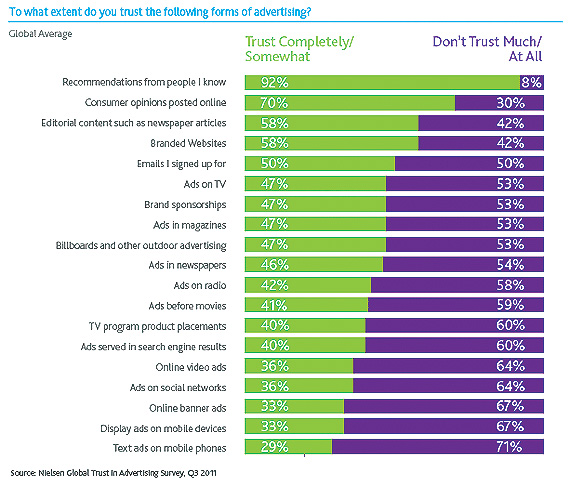
Audience demographics dictate the effectiveness of social media advertising
Social media engagement continues to grow worldwide, particularly among the younger population. Billions of dollars are spent annually by an untold number of companies in marketing their products and services to social media users. The results and the effectiveness of those marketing and sales efforts vary widely by age group, well as does the trust level of consumers.
Mariposa County’s age and economic demographics are similar to many other retirement regions in the USA. Those factors have significant impacts on the use, acceptance and reach of social media with respect to advertising and marketing.
It’s an interesting phenomenon that many folks who use the social media known as Facebook, recently renamed Meta, tend to think everyone else must also be on Facebook.
According to Pew Research, “With the exception of YouTube – used by 83% of adults – no other social media platform comes close to Facebook in usage. Roughly half of adults (47%) report using Instagram, while around a third use Pinterest (35%) and TikTok (33%). About three-in-ten each say they use LinkedIn (30%), WhatsApp (29%) and Snapchat (27%). Smaller shares use X (formerly called Twitter), Reddit and BeReal. Meta owns Facebook, Instagram, and WhatsApp.”
Facebook is popular among all demographic groups, though some adults are more likely to use it than others, the same survey shows. Adults who are more likely to use Facebook include: Women: 76% of women use the platform, compared with 59% of men and Bachelor’s degree holders: 70% of adults with a four-year degree or more education use it, compared with 63% of those who have a high school diploma or less.
Pew Research also reports that three-in-ten Americans say they regularly get news from Facebook, according to a fall 2023 survey. The share of adults who regularly turn to Facebook for news is higher than the share who turn to other platforms, including YouTube (26%), Instagram (16%) and TikTok (14%).
The same report states, “Among Facebook users, 43% say they regularly get news from the site, down from 54%a who said this in 2020. Facebook news consumers are: Mostly women: 62% of those who regularly get news from the site are women, compared with 37% who are men. Other than news consumers or some other major social media sites, 22% of adults who regularly get news on Facebook are under 30, a much lower share than on TikTok (44%), Instagram (42%), and X (36%). Facebook usage is evenly divided politically: 47% are Republicans or Republican-leaning independent, while 46% are Democrats or Democratic leaners.
Not surprisingly, a third of U.S. teens ages 13 to 17 use Facebook, according to a fall 2023 survey of U.S. teens. That’s down sharply from the 71% in this age group who said they used the platform in a 2014-15 survey. Today’s teens tend to gravitate toward other social media platforms, including YouTube (93%) of teens use it), TikTok (63%), Snapchat (60%) and Instagram (59%).
As of August 2023, 23.6 % of Facebook users in the United States were aged between 25 and 34 years, making up Facebook’s largest audience in the country. Overall, 18.4 percent of users belonged to the 18 to 24-year age group. Facebook’s smallest audience can be found amongst teen users, with around one in every 20 users being aged between 13 to 17 years. Additionally, women were slightly more likely to use the platform than men.
How do all those high usage percentages stack up in Mariposa County’s older demographic population?
According to USAFacts.org, a full 30.1% of Mariposa County’s population is 65 years and older. The percentage of population between the ages of 50 to 64 is 20.9%, and 15.3% of the county’s residents, regardless of gender, is between the ages of 35 and 49. The same data base reveals that the county’s fastest growing age group is the 65-plus group, jumping 31.1% between 2020 and 2022.
That means that a full 51% of Mariposa County’s population falls into the two age groups that use Facebook the least.
For businesses solely relying on Facebook to reach Mariposa County consumers, those demographics are daunting.
Kepios (Kepios.com), a reputable digital research firm that boasts “Kepios makes sense of what people are really doing online,” on its website, released a study in April of 2023 entitled Facebook: Advertising Audience Profile. That research shows that after age 34, Facebook usage drops dramatically as the age of the audience elevates.
The Kepios report reveals different Facebook usage percentages when separated by gender than that shown by Pew Research. Since all media research companies employ different methodologies, the results are bound to differ.
The Kepios report shows that 29.5% of the 25-34 age group engage Facebook. Unexpectedly, 12% are women and 17.5% are men. In the next delineated age group, 35-44, Facebook usage plummets to 18.9% of which 8.1% are women and 10.7% men.
The audience continues its downward slide in the 45-54 age group, dropping to 11.5% and almost evenly split between men and women. According to the study, the 55-64-year-old participation is just 7.1%, again evenly divided between the two genders. In the last age category, 65+, the audience plunges to just 5.5%, with 2.9% being women and 2.6% being male.
Consumer trust is another key factor in social media acceptance and influence. The Nielsen Company, considered by most in the communication industry as a global leader in audience measurement, data, and analytics, did a report on consumer trust of online, social, and mobile advertising.
That report states, “The explosion of social networks and consumer-generated media over the last few years continues to have a significant impact on advertising as consumers’ reliance on word-of-mouth in the decision-making process – either from people they know or online consumers they don’t – has increased significantly.
According to Nielsen’s latest Global Trust in Advertising report, which surveyed more than 28,000 Internet respondents in 56 countries, 92 percent of consumers around the world say they trust earned media, such as recommendations from friends and family, above all other forms of advertising—an increase of 18 percent since 2007. Online consumer reviews are the second most trusted source of brand information and messaging, with 70 percent of global consumers surveyed online indicating they trust messages on this platform, an increase of 15 percent in four years.
The survey also showed that nearly six-in-10 global online consumers (58%) trust messages found on company websites, and half trust email messages that they signed up to receive. On the Web, four-in-10 respondents rely on ads served alongside search engine results, 36 percent trust online video advertisements, and one-third believe the messages in online banner ads—an increase of 27 percent since 2007. Sponsored ads on social networks, a new format included in the 2011 Nielsen survey, are credible among 36 percent of global respondents.
Display ads (video or banner) on mobile devices such as tablets and smartphones are trusted by one-third of global respondents, which is slightly higher than the reported consumer trust level of text ads on mobile phones (29%). While the reported consumer trust level in mobile phone advertising is still low, it increased 61 percent since 2007 and 21 percent since 2009.
When it comes to traditional, paid media, while nearly half of consumers around the world say they trust television (47%), magazine (47%) and newspaper ads (46%), confidence declined by 24 percent, 20 percent, and 25 percent, respectively, between 2009 and 2011. Still, in 2011, overall global ad spends saw a seven percent increase over 2010, according to Nielsen’s most recent Global AdView Pulse. This growth in spending was driven by a 10 percent increase in television advertising.”
The Nielson report was released in 2012, so usage levels and trust percentages may vary in today’s market. Apparently, social media’s trust factor continues to grow among the younger population, but in retirement regions like Mariposa County, it appears that traditional media sources are favored by older consumers.
Every advertising firm stands by the traditional practice of not putting every marketing effort into one basket but use a variety of media to deliver the message to prospective customers.


















